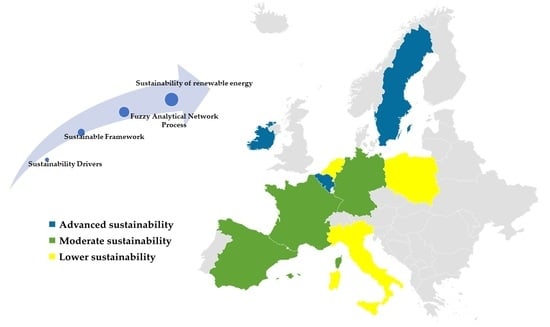Finding Sustainable Countries in Renewable Energy Sector: A Case Study for an EU Energy System
Abstract
1. Introduction
2. Materials and Methods
3. Development
3.1. Case Study (Step 1)
3.2. Sustainable Criteria and Framework (Step 2)
3.2.1. Drivers
3.2.2. Indicator Selection
3.2.3. Principles to Select Indicators of This Study
3.3. Data Sources, and Information Gathering (Step 3)
3.4. FAHP Application, Expert Viewpoints, and Ranking (Steps 4, 5, and 6)
- Making a decision matrix for the alternatives (countries) regarding each criterion
- 2.
- Calculating the summation of all levels (lj, mj, uj) (SM), (Equation (1)):introduces fuzzy numbers.
- 3.
- Calculating the sum of all rows together (SSM), (Equation (2)):whereas a comparison matrix of criteria must always consist of a square matrix, in our context, n = m.
- 4.
- Calculating the inversion of SSM (ISSM), (Equation (3)):
- 5.
- Calculating the fuzzy scores of each alternative (Si = SM ISSM), (Equation (4)):The term Si is known as the fuzzy synthetic extend.
- 6.
- Calculating the superiority (the degree of possibility) of each alternative, (Equation (5)):
- 7.
- Calculating the superiority of criteria over each other (following the same procedure as alternatives (steps 2 to 6)). Then again, a decision matrix should be formed for the pairwise comparison of criteria.
- 8.
- Obtaining the scores for all alternatives. To achieve this, the decision matrix should be normalized, dividing each row by the sum of the rows in that column. The matrix is then multiplied by the corresponding weights. At the end, the obtained points should be normalized to obtain the final points. For more information about the FAHP and its implementation, this study suggests [67,68].
4. Results and Discussions
4.1. Framework and Drivers
4.2. Expert Judgement and Indicators
4.3. Assessing the Sustainability of RE in the Top EU Economy Nations
4.4. Key Factors Influencing Sustainability of RE
4.4.1. Group A (Sweden, Belgium, Ireland)
4.4.2. Group B (France, Germany, Spain)
4.4.3. Group C (The Netherlands, Poland, Italy)
4.4.4. The Effect of Fuzzy Calculation on the Results
4.5. General Discussion and Policy Adjustment
- Developing new mechanisms that can accelerate technological advancements and help achieve carbon neutrality by 2050. This includes establishing medium-term goals for every five-year period.
- Using financial management tools to identify cost-effective and optimal options.
- Developing guideline frameworks that can balance rules, spending, and interests.
- Analyzing the collective responsibility of allocating policy and financial duties across various government levels.
- Conducting research and development to identify the most important social development and research projects that align with the SD goals and Paris Agreement.
- Establishing criteria and supervision mechanisms that can provide continuous feedback from metrics to policy and identifying a set of indicators to measure progress towards the 2050 target and intermediate milestones.
- Lack of consideration of social and environmental impacts: The FAHP methodology mainly considers economic and energy factors in its evaluation, such as the availability of resources and the cost-effectiveness of RE technologies. However, there is a need to incorporate social and environmental impacts such as air and water pollution, land use, and biodiversity loss in the assessment to provide a more comprehensive evaluation of sustainability.
- Data limitations: The availability and quality of data for some countries may be limited, which may affect the accuracy of the assessment. Some countries may also lack transparent reporting on their RE policies, investments, and progress, making it difficult to assess their sustainability accurately.
- Limited scope: The FAHP methodology focuses primarily on RE, and it does not consider other factors that contribute to a country’s sustainability, such as energy efficiency, energy storage, and demand-side management.
- Policy and regulatory gaps: There are differences in policies and regulations between EU countries that can affect their RE sustainability. For example, some countries have more supportive policies and regulations for RE, while others may have limited incentives and a less favorable policy environment.
- Economic challenges: While RE is becoming more cost-competitive, there are still economic challenges in deploying RE technologies, such as the high upfront costs of installations, the intermittency of some RES, and the limited availability of financing.
5. Conclusions
- Sweden could prioritize the strengthening of institutional factors and its overall economic drivers’ score.
- Belgium could concentrate on enhancing performance in non-energy-related aspects, including social, economic, and institutional factors.
- As for Ireland, further enhancement of climate action plans and continued optimization of its approach to energy drivers are crucial. Lastly, improving the institutional factor to achieve a higher rating is suggested.
- France: place emphasis on gradually increasing the share of RE over time and address areas in need of improvement within the social factors’ category.
- Germany: enhance energy factors, improve the economic factors, and strengthen institutional aspects while maintaining acceptable levels in social and environmental factors.
- Spain: give more attention to social and economic factors, with the aim of achieving a better situation amidst other countries.
- The Netherlands: it would be better to concentrate on reducing the dependency on fossil fuels; improving environmental, institutional, economic, and energy factors; and maintaining the progress in social factors.
- Poland: it could address the impact of GDP and the inflation rate on RE, enhance the share of RES, and focus on improving economic factors.
- Italy: it could work on improving social factors and energy factors (especially energy intensity and general energy production) and addressing employment rate and HDI.
Author Contributions
Funding
Institutional Review Board Statement
Informed Consent Statement
Data Availability Statement
Conflicts of Interest
Abbreviations
| AHP | Analytical Hierarchy Process |
| BP | British Petroleum |
| CO2 | Carbon Dioxide |
| EU | European Union |
| FAHP | Fuzzy Analytical Hierarchy Process |
| GDP | Gross Domestic Product |
| GHG | Greenhouse Gas |
| HDI | Human Development Index |
| IEA | International Energy Agency |
| KPIs | Key Performance Indicators |
| MATLAB® | Matrix Laboratory |
| MCDM | Multi-Criteria Decision-Making |
| OECD | Organization for Economic Co-operation and Development |
| RE | Renewable Energy |
| RES | Renewable Energy Sources |
| SD | Sustainable Development |
| SDGs | Sustainable Development Goals |
| TBL | Triple Bottom Line |
References
- Dincer, I. Renewable energy and sustainable development: A crucial review. Renew. Sustain. Energy Rev. 2000, 4, 157–175. [Google Scholar] [CrossRef]
- Vakulchuk, R.; Overland, I.; Scholten, D. Renewable energy and geopolitics: A review. Renew. Sustain. Energy Rev. 2020, 122, 109547. [Google Scholar] [CrossRef]
- Matsumoto, K.; Doumpos, M.; Andriosopoulos, K. Historical energy security performance in EU countries. Renew. Sustain. Energy Rev. 2018, 82, 1737–1748. [Google Scholar] [CrossRef]
- Taylor, P.G.; Abdalla, K.; Quadrelli, R.; Vera, I. Better energy indicators for sustainable development. Nat. Energy 2017, 2, 17117. [Google Scholar] [CrossRef]
- Swain, R.B.; Karimu, A. Renewable electricity and sustainable development goals in the EU. World Dev. 2020, 125, 104693. [Google Scholar] [CrossRef]
- Simsek, Y.; Santika, W.G.; Anisuzzaman, M.; Urmee, T.; Bahri, P.A.; Escobar, R. An analysis of additional energy requirement to meet the sustainable development goals. J. Clean. Prod. 2020, 272, 122646. [Google Scholar] [CrossRef]
- Santika, W.G.; Anisuzzaman, M.; Bahri, P.A.; Shafiullah, G.M.; Rupf, G.V.; Urmee, T. From goals to joules: A quantitative approach of interlinkages between energy and the Sustainable Development Goals. Energy Res. Soc. Sci. 2019, 50, 201–214. [Google Scholar] [CrossRef]
- Saidi, K.; Omri, A. The impact of renewable energy on carbon emissions and economic growth in 15 major renewable energy-consuming countries. Environ. Res. 2020, 186, 109567. [Google Scholar] [CrossRef]
- Fathima, A.H.; Palanisamy, K. Optimization in microgrids with hybrid energy systems—A review. Renew. Sustain. Energy Rev. 2015, 45, 431–446. [Google Scholar] [CrossRef]
- Ringkjøb, H.K.; Haugan, P.M.; Solbrekke, I.M. A review of modelling tools for energy and electricity systems with large shares of variable renewables. Renew. Sustain. Energy Rev. 2018, 96, 440–459. [Google Scholar] [CrossRef]
- Cuesta, M.A.; Castillo-Calzadilla, T.; Borges, C.E. A critical analysis on hybrid renewable energy modeling tools: An emerging opportunity to include social indicators to optimise systems in small communities. Renew. Sustain. Energy Rev. 2020, 122, 109691. [Google Scholar] [CrossRef]
- Su, W.; Ye, Y.; Zhang, C.; Baležentis, T.; Štreimikienė, D. Sustainable energy development in the major power-generating countries of the European Union: The Pinch Analysis. J. Clean. Prod. 2020, 256, 120696. [Google Scholar] [CrossRef]
- Ntanos, S.; Skordoulis, M.; Kyriakopoulos, G.; Arabatzis, G.; Chalikias, M.; Galatsidas, S.; Batzios, A.; Katsarou, A. Renewable energy and economic growth: Evidence from European countries. Sustainability 2018, 10, 2626. [Google Scholar] [CrossRef]
- Marinaş, M.C.; Dinu, M.; Socol, A.G.; Socol, C. Renewable energy consumption and economic growth. Causality relationship in Central and Eastern European countries. PLoS ONE 2018, 13, e0202951. [Google Scholar] [CrossRef]
- Rafindadi, A.A.; Ozturk, I. Impacts of renewable energy consumption on the German economic growth: Evidence from combined cointegration test. Renew. Sustain. Energy Rev. 2017, 75, 1130–1141. [Google Scholar] [CrossRef]
- Zafar, M.W.; Shahbaz, M.; Hou, F.; Sinha, A. From nonrenewable to renewable energy and its impact on economic growth: The role of research & development expenditures in Asia-Pacific Economic Cooperation countries. J. Clean. Prod. 2019, 212, 1166–1178. [Google Scholar] [CrossRef]
- Shahbaz, M.; Raghutla, C.; Chittedi, K.R.; Jiao, Z.; Vo, X.V. The effect of renewable energy consumption on economic growth: Evidence from the renewable energy country attractive index. Energy 2020, 207, 118162. [Google Scholar] [CrossRef]
- Ben Mbarek, M.; Saidi, K.; Amamri, M. The relationship between pollutant emissions, renewable energy, nuclear energy and GDP: Empirical evidence from 18 developed and developing countries. Int. J. Sustain. Energy 2018, 37, 597–615. [Google Scholar] [CrossRef]
- Bhattacharya, M.; Awaworyi Churchill, S.; Paramati, S.R. The dynamic impact of renewable energy and institutions on economic output and CO2 emissions across regions. Renew. Energy 2017, 111, 157–167. [Google Scholar] [CrossRef]
- Candra, O.; Chammam, A.; Alvarez, J.R.N.; Muda, I.; Aybar, H.Ş. The Impact of Renewable Energy Sources on the Sustainable Development of the Economy and Greenhouse Gas Emissions. Sustainability 2023, 15, 2104. [Google Scholar] [CrossRef]
- Hou, H.; Lu, W.; Liu, B.; Hassanein, Z.; Mahmood, H.; Khalid, S. Exploring the Role of Fossil Fuels and Renewable Energy in Determining Environmental Sustainability: Evidence from OECD Countries. Sustainability 2023, 15, 2048. [Google Scholar] [CrossRef]
- Wang, Q.; Zhan, L. Assessing the sustainability of renewable energy: An empirical analysis of selected 18 European countries. Sci. Total Environ. 2019, 692, 529–545. [Google Scholar] [CrossRef]
- Davidson, N.; Maksimova, E.; Mariev, O. How does renewable energy consumption affect economic growth? Evidence from the European Union countries. SHS Web Conf. 2021, 129, 09005. [Google Scholar] [CrossRef]
- Abbasi, K.; Jiao, Z.; Shahbaz, M.; Khan, A. Asymmetric impact of renewable and non-renewable energy on economic growth in Pakistan: New evidence from a nonlinear analysis. Energy Explor. Exploit. 2020, 38, 1946–1967. [Google Scholar] [CrossRef]
- European Parliament and of the Council. Council Directive 2008/1/EC of the European Parliament and of the Council of European Commission of 15 January 2008 Concerning Integrated Pollution Prevention and Control. Available online: http://data.europa.eu/eli/dir/2008/1/oj (accessed on 28 November 2022).
- European Parliament and of the Council. Directive 2012/19/EU of the European Parliament and of the Council of 4 July 2012 on Waste Electrical and Electronic Equipment (WEEE) (Recast) Text with EEA Relevance. Available online: http://data.europa.eu/eli/dir/2012/19/oj (accessed on 28 November 2022).
- Elkington, J. Towards the Sustainable Corporation: Win-Win-Win Business Strategies for Sustainable Development. Calif. Manag. Rev. 1994, 36, 90–100. [Google Scholar] [CrossRef]
- Elkington, J. Partnerships fromcannibals with forks: The triple bottom line of 21st-century business. Environ. Qual. Manag. 1998, 8, 37–51. [Google Scholar] [CrossRef]
- Kirchherr, J.; Reike, D.; Hekkert, M. Conceptualizing the circular economy: An analysis of 114 definitions. Resour. Conserv. Recycl. 2017, 127, 221–232. [Google Scholar] [CrossRef]
- Iddrisu, I.; Bhattacharyya, S.C. Sustainable Energy Development Index: A multi-dimensional indicator for measuring sustainable energy development. Renew. Sustain. Energy Rev. 2015, 50, 513–530. [Google Scholar] [CrossRef]
- Kahraman, C.; Kaya, I.; Cebi, S. A comparative analysis for multiattribute selection among renewable energy alternatives using fuzzy axiomatic design and fuzzy analytic hierarchy process. Energy 2009, 34, 1603–1616. [Google Scholar] [CrossRef]
- Štreimikiene, D.; Šliogeriene, J.; Turskis, Z. Multi-criteria analysis of electricity generation technologies in Lithuania. Renew. Energy 2016, 85, 148–156. [Google Scholar] [CrossRef]
- Al Garni, H.; Kassem, A.; Awasthi, A.; Komljenovic, D.; Al-Haddad, K. A multicriteria decision making approach for evaluating renewable power generation sources in Saudi Arabia. Sustain. Energy Technol. Assess. 2016, 16, 137–150. [Google Scholar] [CrossRef]
- Velenturf, A.P.M.; Purnell, P. Principles for a sustainable circular economy. Sustain. Prod. Consum. 2021, 27, 1437–1457. [Google Scholar] [CrossRef]
- Bali Swain, R.; Ranganathan, S. Modeling interlinkages between sustainable development goals using network analysis. World Dev. 2021, 138, 105136. [Google Scholar] [CrossRef]
- Liu, G. Development of a general sustainability indicator for renewable energy systems: A review. Renew. Sustain. Energy Rev. 2014, 31, 611–621. [Google Scholar] [CrossRef]
- Bouyssou, D. Building Criteria: A Prerequisite for MCDA. In Readings in Multiple Criteria Decision Aid; Bana e Costa, C.A., Ed.; Springer: Berlin/Heidelberg, German, 1990; pp. 58–80. [Google Scholar] [CrossRef]
- Hák, T.; Janoušková, S.; Moldan, B. Sustainable Development Goals: A need for relevant indicators. Ecol. Indic. 2016, 60, 565–573. [Google Scholar] [CrossRef]
- Pintér, L.; Hardi, P.; Bartelmus, P. Sustainable Development Indicators: Proposals for the Way Forward; International Institute for Sustainable Development: New York, NY, USA, 2005; pp. 1–35. Available online: https://sostenibilidadurbana.files.wordpress.com/2008/12/measure_isd_way_forward_un-dsd.pdf (accessed on 20 November 2022).
- Krellenberg, K.; Kopfmüller, J.; Arton, J. How Sustainable Is Santiago de Chile? Current Performance, Future Trends, Potential Measures. Leipzig: Helmholtz-Centre for Environmental Research—UFZ. October 2010. Available online: https://www.dlr.de/dlr/Portaldata/1/Resources/documents/2011_1/Synthesis_Report_Megacities_english.pdf (accessed on 20 November 2022).
- Rickels, W.; Dovern, J.; Hoffmann, J.; Quaas, M.F.; Schmidt, J.O.; Visbeck, M. Indicators for monitoring sustainable development goals: An application to oceanic development in the European Union. Earths Future 2016, 4, 252–267. [Google Scholar] [CrossRef]
- Alfsen, K.H.; Greaker, M. From natural resources and environmental accounting to construction of indicators for sustainable development. Ecol. Econ. 2007, 61, 600–610. [Google Scholar] [CrossRef]
- Schultz, J.; Brand, F.; Kopfmüller, J.; Ott, K. Building a ‘theory of sustainable development’: Two salient conceptions within the German discourse. Int. J. Environ. Sustain. Dev. 2008, 7, 465–482. [Google Scholar] [CrossRef]
- Dawoud, S.M.; Lin, X.; Okba, M.I. Hybrid renewable microgrid optimization techniques: A review. Renew. Sustain. Energy Rev. 2018, 82, 2039–2052. [Google Scholar] [CrossRef]
- Tezer, T.; Yaman, R.; Yaman, G. Evaluation of approaches used for optimization of stand-alone hybrid renewable energy systems. Renew. Sustain. Energy Rev. 2017, 73, 840–853. [Google Scholar] [CrossRef]
- Bekhrad, K.; Aslani, A.; Mazzuca-Sobczuk, T. Energy security in Andalusia: The role of renewable energy sources. Case Stud. Chem. Environ. Eng. 2020, 1, 100001. [Google Scholar] [CrossRef]
- Cîrstea, S.D.; Moldovan-Teselios, C.; Cîrstea, A.; Turcu, A.C.; Darab, C.P. Evaluating renewable energy sustainability by composite index. Sustainability 2018, 10, 811. [Google Scholar] [CrossRef]
- International Energy Agency. International Energy Agency (IEA) World Energy Outlook 2022. Available online: https://www.iea.org/reports/world-energy-outlook-2022 (accessed on 20 November 2022).
- Saaty, T.L. The Analytic Hierarchy Process: Planning, Priority Setting, Resource Allocation, 1st ed.; McGraw-Hill International Book Co.: New York, NY, USA, 1980; pp. 271–278. ISBN 100070543712. [Google Scholar]
- Doukas, H.; Psarras, J. A linguistic decision support model towards the promotion of renewable energy. Energy Sources B Econ. Plan. Policy 2009, 4, 166–178. [Google Scholar] [CrossRef]
- Grilli, G.; De Meo, I.; Garegnani, G.; Paletto, A. A multi-criteria framework to assess the sustainability of renewable energy development in the Alps. J. Environ. Plan. Manag. 2017, 60, 1276–1295. [Google Scholar] [CrossRef]
- Saaty, T.L. The Analytic Hierarchy Process: Decision Making in Complex Environments. In Quantitative Assessment in Arms Control, 1st ed.; Springer: Boston, MA, USA, 1984; pp. 285–308. ISBN 978-1-4613-2805-6. [Google Scholar] [CrossRef]
- Ahmad, S.; Tahar, R.M. Selection of renewable energy sources for sustainable development of electricity generation system using analytic hierarchy process: A case of Malaysia. Renew. Energy 2014, 63, 458–466. [Google Scholar] [CrossRef]
- Mastrocinque, E.; Ramírez, F.J.; Honrubia-Escribano, A.; Pham, D.T. An AHP-based multi-criteria model for sustainable supply chain development in the renewable energy sector. Expert Syst. Appl. 2020, 150, 113321. [Google Scholar] [CrossRef]
- Haddad, B.; Liazid, A.; Ferreira, P. A multi-criteria approach to rank renewables for the Algerian electricity system. Renew. Energy 2017, 107, 462–472. [Google Scholar] [CrossRef]
- Shaaban, M.; Scheffran, J.; Böhner, J.; Elsobki, M. Sustainability Assessment of Electricity Generation Technologies in Egypt Using Multi-Criteria Decision Analysis. Renew. Energy 2017, 107, 462–472. [Google Scholar] [CrossRef]
- Atilgan, B.; Azapagic, A. An integrated life cycle sustainability assessment of electricity generation in Turkey. Energy Policy 2016, 93, 168–186. [Google Scholar] [CrossRef]
- Lee, C.W.; Zhong, J. Construction of a responsible investment composite index for renewable energy industry. Renew. Sustain. Energy Rev. 2015, 51, 288–303. [Google Scholar] [CrossRef]
- Dhital, R.P.; Pyakurel, P.; Bajracharya, T.R.; Shrestha, R. Framework for sustainability assessment of renewable energy projects in nepal. Int. J. Anal. Hierarchy Process 2014, 6, 76–92. [Google Scholar] [CrossRef]
- Dombi, M.; Kuti, I.; Balogh, P. Sustainability assessment of renewable power and heat generation technologies. Energy Policy 2014, 67, 264–271. [Google Scholar] [CrossRef]
- Demirtas, O. Evaluating the Best Renewable Energy Technology for Sustainable Energy Planning. Int. J. Energy Econ. Policy 2013, 3, 23–33. [Google Scholar]
- Dimić, V.; Milošević, M.; Milošević, D.; Stević, D. Adjustable model of renewable energy projects for sustainable development: A case study of the Nišava District in Serbia. Sustainability 2018, 10, 755. [Google Scholar] [CrossRef]
- Ligus, M. Evaluation of Economic, Social and Environmental Effects of Low-Emission Energy Technologies Development in Poland: A Multi-Criteria Analysis with Application of a Fuzzy Analytic Hierarchy Process (FAHP). Energies 2017, 10, 1550. [Google Scholar] [CrossRef]
- Ertay, T.; Kahraman, C.; Kaya, I. Evaluation of renewable energy alternatives using MACBETH and fuzzy AHP multicriteria methods: The case of Turkey. Technol. Econ. Dev. Econ. 2013, 19, 38–62. [Google Scholar] [CrossRef]
- Heo, E.; Kim, J.; Boo, K.J. Analysis of the assessment factors for renewable energy dissemination program evaluation using fuzzy AHP. Renew. Sustain. Energy Rev. 2010, 14, 2214–2220. [Google Scholar] [CrossRef]
- Shen, Y.C.; Lin, G.T.R.; Li, K.P.; Yuan, B.J.C. An assessment of exploiting renewable energy sources with concerns of policy and technology. Energy Policy 2010, 38, 4604–4616. [Google Scholar] [CrossRef]
- Chang, D.-Y. Applications of the extent analysis method on fuzzy AHP. Eur. J. Oper. Res. 1996, 95, 649–655. [Google Scholar] [CrossRef]
- Emrouznejad, A.; Ho, W. Fuzzy Analytic Hierarchy Process; CRC Press: Boca Raton, FL, USA, 2017; pp. 3–407. ISBN 9781498732468. [Google Scholar] [CrossRef]
- Kourkoumpas, D.S.; Benekos, G.; Nikolopoulos, N.; Karellas, S.; Grammelis, P.; Kakaras, E. A review of key environmental and energy performance indicators for the case of renewable energy systems when integrated with storage solutions. Appl. Energy 2018, 231, 380–398. [Google Scholar] [CrossRef]
- Onat, N.; Bayar, H. The sustainability indicators of power production systems. Renew. Sustain. Energy Rev. 2010, 14, 3108–3115. [Google Scholar] [CrossRef]
- Shaaban, M.; Scheffran, J. Selection of sustainable development indicators for the assessment of electricity production in Egypt. Sustain. Energy Technol. Assess. 2017, 22, 65–73. [Google Scholar] [CrossRef]
- Boran, F.E. A new approach for evaluation of renewable energy resources: A case of Turkey. Energy Sources B Econ. Plan. Policy 2018, 13, 196–204. [Google Scholar] [CrossRef]
- Ifaei, P.; Karbassi, A.; Lee, S.; Yoo, C.K. A renewable energies-assisted sustainable development plan for Iran using techno-econo-socio-environmental multivariate analysis and big data. Energy Convers Manag. 2017, 153, 257–277. [Google Scholar] [CrossRef]
- Strantzali, E.; Aravossis, K. Decision making in renewable energy investments: A review. Renew. Sustain. Energy Rev. 2016, 55, 885–898. [Google Scholar] [CrossRef]
- Diemuodeke, E.O.; Hamilton, S.; Addo, A. Multi-criteria assessment of hybrid renewable energy systems for Nigeria’s coastline communities. Energy Sustain. Soc. 2016, 6, 26. [Google Scholar] [CrossRef]
- Şengül, Ü.; Eren, M.; Eslamian Shiraz, S.; Gezder, V.; Sengül, A.B. Fuzzy TOPSIS method for ranking renewable energy supply systems in Turkey. Renew. Energy 2015, 75, 617–625. [Google Scholar] [CrossRef]
- Mourmouris, J.C.; Potolias, C. A multi-criteria methodology for energy planning and developing renewable energy sources at a regional level: A case study Thassos, Greece. Energy Policy 2013, 52, 522–530. [Google Scholar] [CrossRef]
- Troldborg, M.; Heslop, S.; Hough, R.L. Assessing the sustainability of renewable energy technologies using multi-criteria analysis: Suitability of approach for national-scale assessments and associated uncertainties. Renew. Sustain. Energy Rev. 2014, 39, 1173–1184. [Google Scholar] [CrossRef]
- Zhao, Z.Y.; Chen, Y.L. Critical factors affecting the development of renewable energy power generation: Evidence from China. J. Clean. Prod. 2018, 184, 466–480. [Google Scholar] [CrossRef]
- Wang, Q.; Yang, X. Investigating the sustainability of renewable energy—An empirical analysis of European Union countries using a hybrid of projection pursuit fuzzy clustering model and accelerated genetic algorithm based on real coding. J. Clean. Prod. 2020, 268, 121940. [Google Scholar] [CrossRef]
- Armeanu, D.Ş.; Vintilǎ, G.; Gherghina, Ş.C. Does renewable energy drive sustainable economic growth? Multivariate panel data evidence for EU-28 countries. Energies 2017, 10, 381. [Google Scholar] [CrossRef]
- Böhringer, C.; Cuntz, A.; Harhoff, D.; Asane-Otoo, E. The impact of the German feed-in tariff scheme on innovation: Evidence based on patent filings in renewable energy technologies. Energy Econ. 2017, 67, 545–553. [Google Scholar] [CrossRef]
- Stougie, L.; Giustozzi, N.; van der Kooi, H.; Stoppato, A. Environmental, economic and exergetic sustainability assessment of power generation from fossil and renewable energy sources. Int. J. Energy Res. 2018, 42, 2916–2926. [Google Scholar] [CrossRef]
- Hanne, L.R.; Ingunn, S.M.; Tor, H.B. Energy Indicators for Electricity Production: Comparing Technologies and the Nature of the Indicators Energy Payback Ratio (EPR), Net Energy Ratio (NER) and Cumulative Energy Demand (CED). Oestfoldforskning. 2012. Available online: https://www.osti.gov/etdeweb/biblio/22000101 (accessed on 22 November 2022).
- Yu, S.; Zheng, Y.; Li, L. A comprehensive evaluation of the development and utilization of China’s regional renewable energy. Energy Policy 2019, 127, 73–86. [Google Scholar] [CrossRef]
- Duarte, R.; García-Riazuelo, Á.; Sáez, L.A.; Sarasa, C. Analysing citizens’ perceptions of renewable energies in rural areas: A case study on wind farms in Spain. Energy Rep. 2022, 8, 12822–12831. [Google Scholar] [CrossRef]
- Zhao, H.; Guo, S. External benefit evaluation of renewable energy power in China for sustainability. Sustainability 2015, 7, 4783–4805. [Google Scholar] [CrossRef]
- International Energy Agency (IEA). Energy Efficiency Investment, 2015–2021. Available online: https://www.iea.org/data-and-statistics/charts/energy-efficiency-investment-2015-2021 (accessed on 22 November 2022).
- Gyamfi, B.A.; Kwakwa, P.A.; Adebayo, T.S. Energy intensity among European Union countries: The role of renewable energy, income and trade. Int. J. Energy Sect. Manag. 2023, 17, 801–819. [Google Scholar] [CrossRef]
- Pratama, Y.W.; Purwanto, W.W.; Tezuka, T.; McLellan, B.C.; Hartono, D.; Hidayatno, A.; Daud, Y. Multi-objective optimization of a multiregional electricity system in an archipelagic state: The role of renewable energy in energy system sustainability. Renew. Sustain. Energy Rev. 2017, 77, 423–439. [Google Scholar] [CrossRef]
- Ghenai, C.; Albawab, M.; Bettayeb, M. Sustainability indicators for renewable energy systems using multi-criteria decision-making model and extended SWARA/ARAS hybrid method. Renew. Energy 2020, 146, 580–597. [Google Scholar] [CrossRef]
- Dominković, D.F.; Bačeković, I.; Pedersen, A.S.; Krajačić, G. The future of transportation in sustainable energy systems: Opportunities and barriers in a clean energy transition. Renew. Sustain. Energy Rev. 2018, 82, 1823–1838. [Google Scholar] [CrossRef]
- SDSN; IEEP. The 2019 Europe Sustainable Development Report. Sustainable Development Solutions Network and Institute for European Environmental Policy; Pica Publishing: Paris, France; Brussels, Belgium, 2019. [Google Scholar]
- Kylili, A.; Thabit, Q.; Nassour, A.; Fokaides, P.A. Adoption of a holistic framework for innovative sustainable renewable energy development: A case study. In Energy Sources, Part A: Recovery, Utilization, and Environmental Effects; Taylor and Francis: Abingdon, UK, 2021; pp. 1–21. [Google Scholar] [CrossRef]
- Huck, W.; Maaß, J.; Sood, S.; Benmaghnia, T.; Heß, S.M. Framework and content of energy transition in Southeast Asia with ASEAN and the EU. J. World Energy Law Bus. 2022, 15, 396–408. [Google Scholar] [CrossRef]
- Nouri, A.; Khadem, S.; Mutule, A.; Papadimitriou, C.; Stanev, R.; Cabiati, M.; Keane, A.; Carroll, P. Identification of Gaps and Barriers in Regulations, Standards, and Network Codes to Energy Citizen Participation in the Energy Transition. Energies 2022, 15, 856. [Google Scholar] [CrossRef]
- Mata Pérez, M.d.l.E.; Scholten, D.; Stegen, K.S. The multi-speed energy transition in Europe: Opportunities and challenges for EU energy security. Energy Strategy Rev. 2019, 26, 100415. [Google Scholar] [CrossRef]
- Wise, D.N.; Stoilov, D. Energy Integration in the European Union—Traditional Approaches and Future Research Avenues. In Proceedings of the 13th Electrical Engineering Faculty Conference (BulEF), Varna, Bulgaria, 8–11 September 2021. [Google Scholar] [CrossRef]
- Rajavuori, M.; Huhta, K. Investment screening: Implications for the energy sector and energy security. Energy Policy 2020, 144, 111646. [Google Scholar] [CrossRef]
- Jałowiec, T.; Wojtaszek, H.; Miciuła, I. Green Energy Management through the Implementation of RES in the EU. Analysis of the Opinions of Poland and Germany. Energies 2021, 14, 8097. [Google Scholar] [CrossRef]
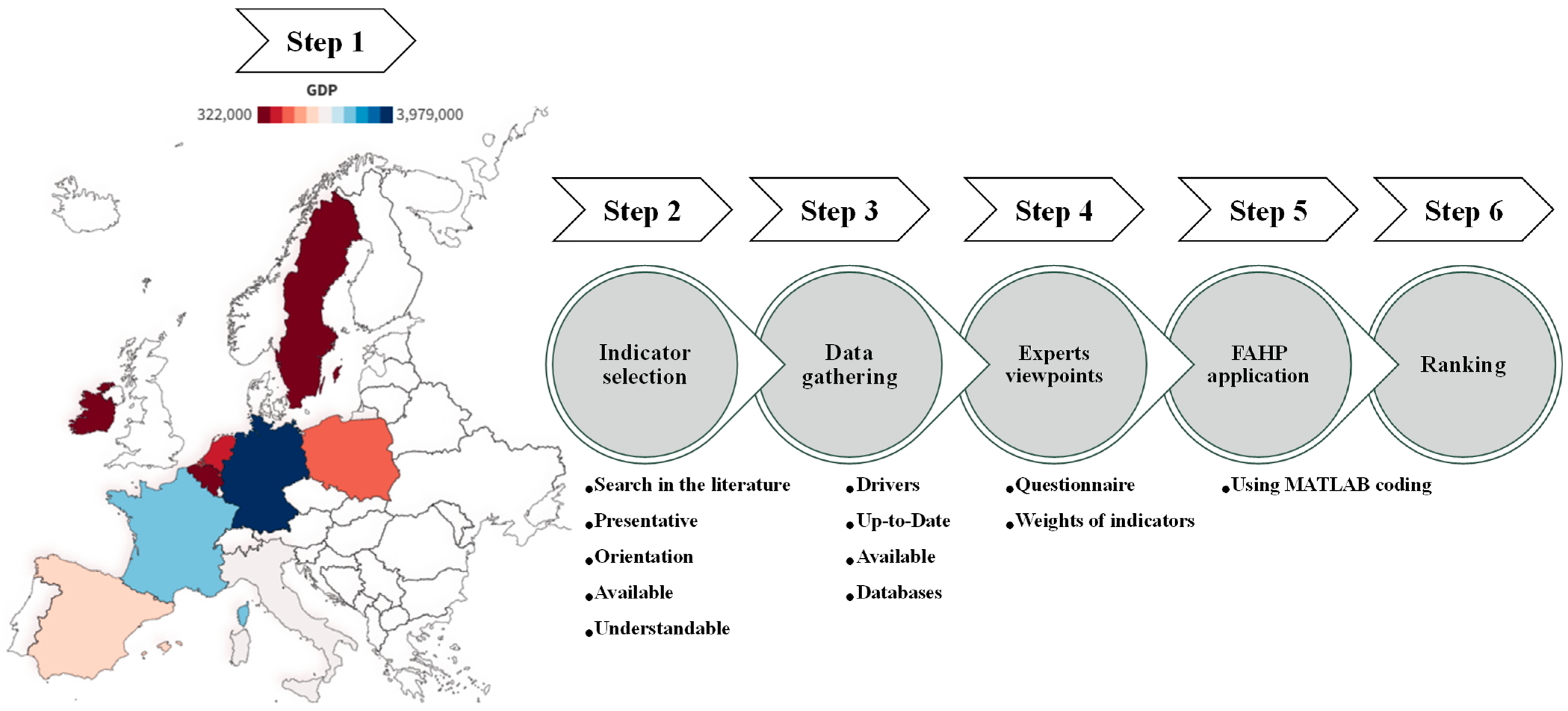

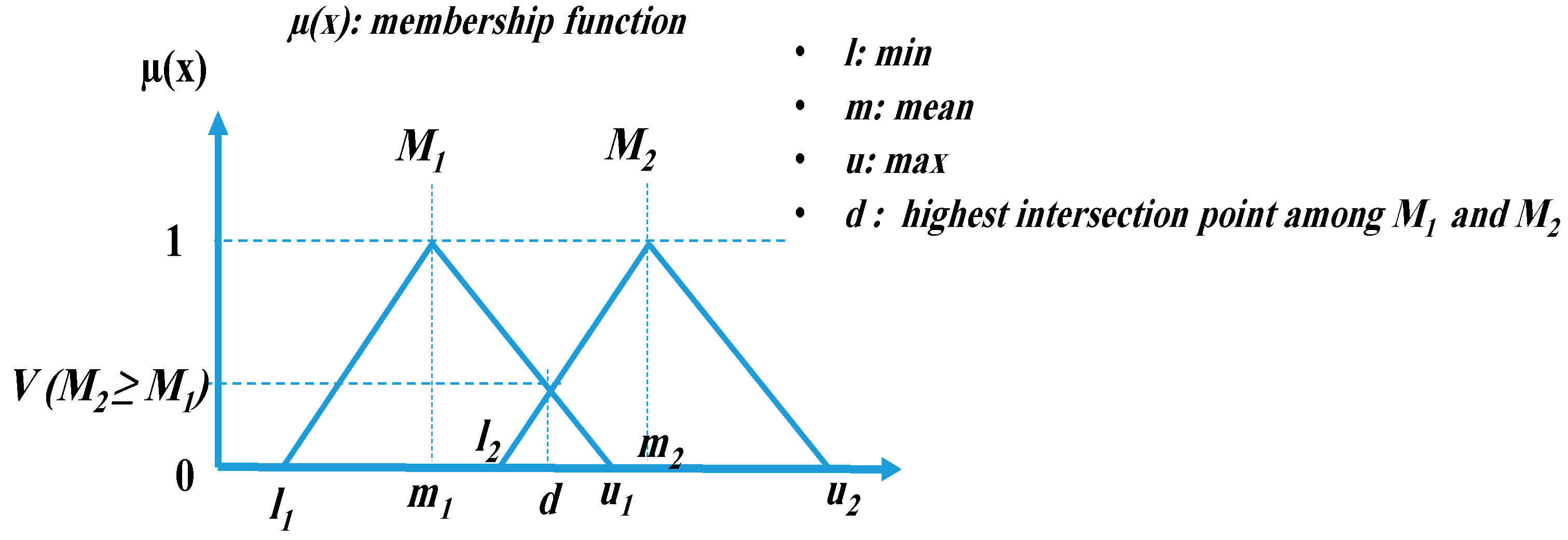
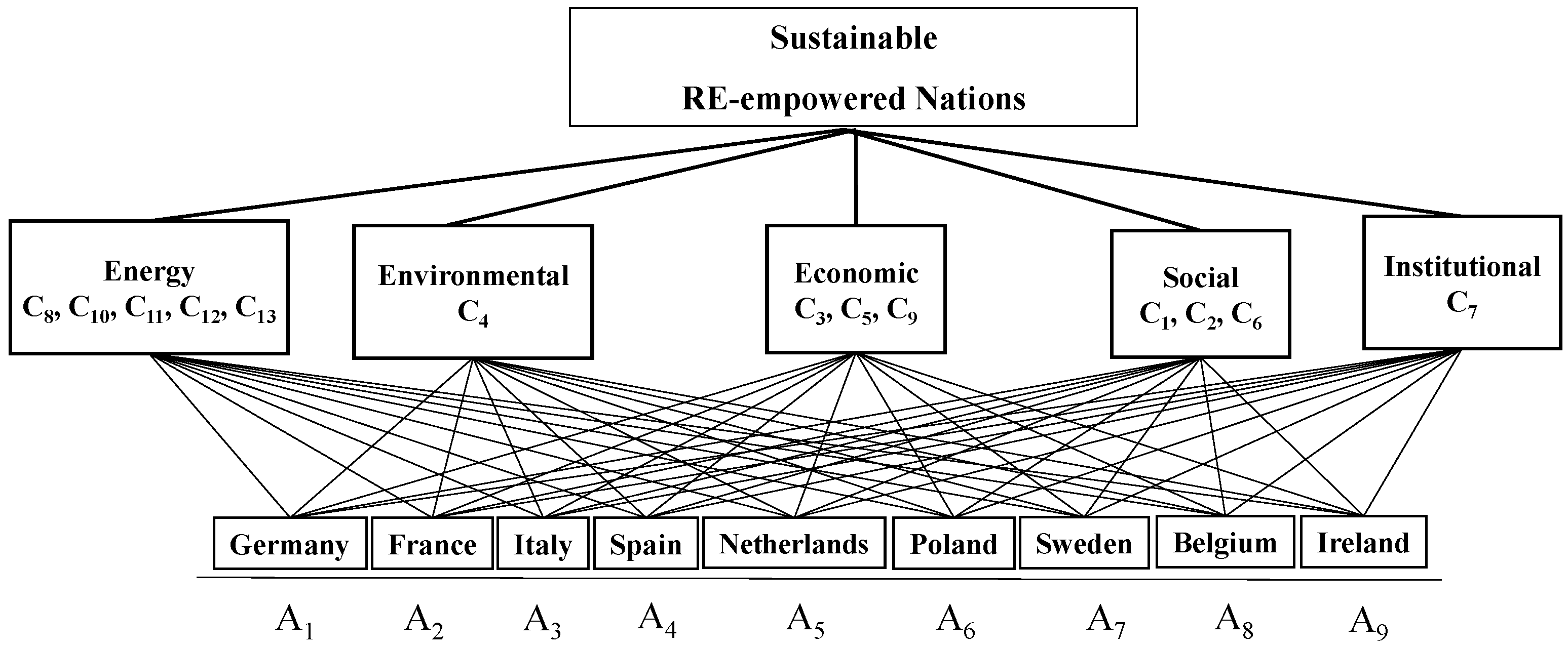
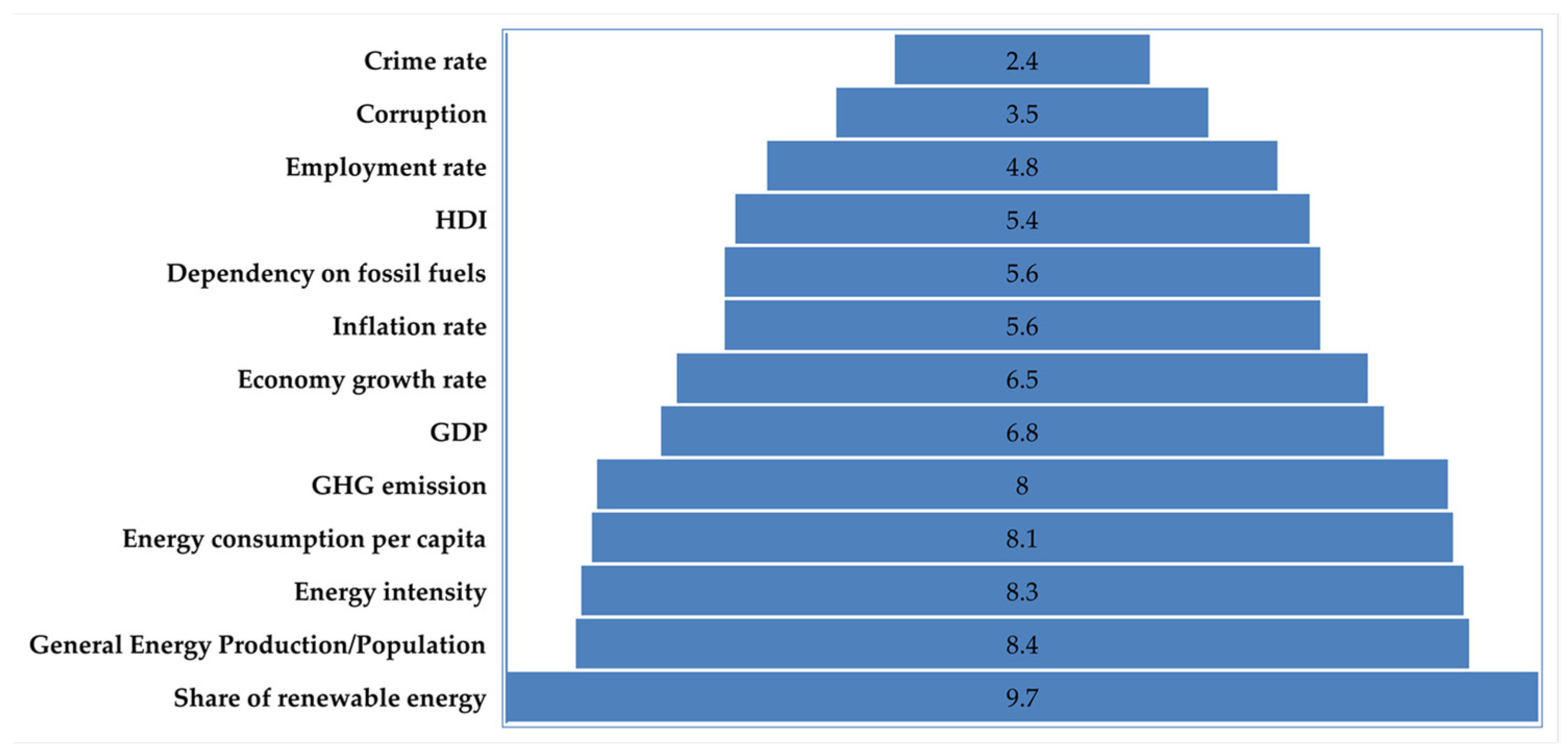
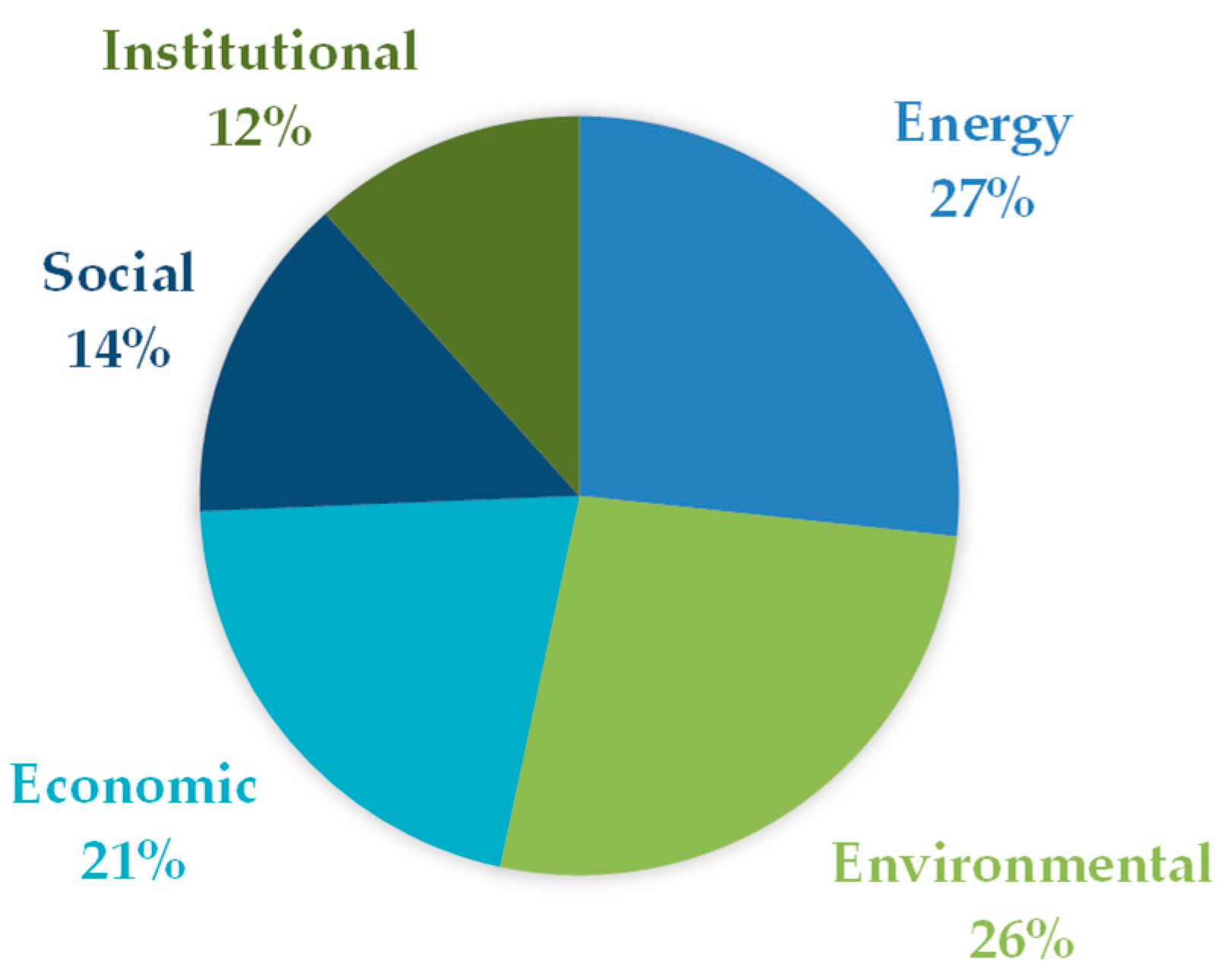
| Methodology | Drivers | Scope of Sustainability | Ref. |
|---|---|---|---|
| AHP | Environment, Economic, Social | Assessing Sustainability of RE | [54] |
| AHP | Environment, Economic, Social, Technical | RE Technology and Systems Assessment | [56] |
| AHP | Environment, Economic, Social, Technical | RE Sources | [55] |
| AHP | Environment, Economic, Social | Assessing RE Power Generation | [57] |
| AHP | Environment, Economic, Social, Technical | Assessing RE Power Generation | [33] |
| AHP | Environment, Economic, Social, Institutional | RE Investment | [58] |
| AHP | Environment, Economic, Social, Technical | RE Sources | [53] |
| AHP | Environment, Economic, Social, Technical | Assessing Sustainability of RE | [59] |
| AHP | Environment, Economic, Social | RE Technology and Systems Assessment | [60] |
| AHP | Environment, Economic, Social, Technical | RE Technology and Energy Planning | [61] |
| FAHP | Environment, Technical, Organizational | RE Projects | [62] |
| FAHP | Environment, Economic, Social | RE Technology and Systems Assessment | [63] |
| FAHP | Environment, Economic, Social, Technical | RE Technology and Systems Assessment | [64] |
| FAHP | Environment, Economic, Social, Technical, Institutional | RE Projects | [65] |
| FAHP | Energy, Environment, Economic | RE Projects | [66] |
| FAHP | Environment, Economic, Social, Technical | RE Technology and Energy Planning | [31] |
| Saaty Scale | The Verbal Expression of the Comparative Situation of i with Respect to j | Fuzzy Triangular Scale |
|---|---|---|
| 1 | Preferred equally | (1, 1, 1) |
| 2 | In between | (1, 2, 3) |
| 3 | Preferred moderately | (2, 3, 4) |
| 4 | In between | (3, 4, 5) |
| 5 | Preferred strongly | (4, 5, 6) |
| 6 | In between | (5, 6, 7) |
| 7 | Very strongly preferred | (6, 7, 8) |
| 8 | In between | (7, 8, 9) |
| 9 | Extremely preferred | (9, 9, 9) |
| For Criteria jth (Cj) | Alternatives | |||||||||
|---|---|---|---|---|---|---|---|---|---|---|
| A1,1 | A2,2 | … | Ai,j | |||||||
| A1,1 | 1.00 | 1.00 | 1.00 | 1.00 | 2.33 | 5.00 | … | l1,j | m1,j | u1,j |
| A2,2 | 0.20 | 0.73 | 1.00 | 1.00 | 1.00 | 1.00 | … | l2,j | m2,j | u2,j |
| . | . | . | . | . | . | . | … | . | . | . |
| . | . | . | . | . | . | . | … | . | . | . |
| . | . | . | . | . | . | . | … | . | . | . |
| Ai,j | lj,1 | mj,1 | uj,1 | lj,2 | mj,2 | ui,2 | … | 1.00 | 1.00 | 1.00 |
| Indicator/(Criteria) | Germany | France | Italy | Spain | Netherlands | Poland | Sweden | Belgium | Ireland | Direction | Unit | Refs. |
|---|---|---|---|---|---|---|---|---|---|---|---|---|
| Employment rate (C1) | 0.111 | 0.097 | 0.086 | 0.074 | 0.117 | 0.102 | 0.099 | 0.095 | 0.105 | + | % | [31,58,63,73,81,82] |
| HDI (C2) | 0.102 | 0.098 | 0.097 | 0.098 | 0.102 | 0.095 | 0.102 | 0.101 | 0.102 | + | % | [11] |
| GDP (C3) | 0.355 | 0.325 | 0.267 | 0.235 | 0.419 | 0.138 | 0.448 | 0.360 | 0.705 | + | Euro per capita/100,000 | [47] |
| GHG emission (C4) | 9.56 | 6.01 | 6.62 | 5.80 | 10.29 | 10.33 | 4.80 | 9.56 | 12.90 | − | Ton per capita | [66,78,83,84] |
| Economy growth rate (C5) | 2.60 | 6.80 | 6.70 | 5.50 | 4.90 | 6.80 | 5.10 | 7.60 | 13.60 | + | % | [47,85] |
| Crime rate (C6) | 35.79 | 51.99 | 44.85 | 33.32 | 27.16 | 30.50 | 48.00 | 44.58 | 45.51 | − | Ratio | [86] |
| Corruption (C7) | 80 | 71 | 56 | 61 | 82 | 56 | 85 | 73 | 74 | − | % | [58] |
| Dependency on fossil fuels (C8) | 31,647 | 19,916 | 23,873 | 22,769 | 48,688 | 30,111 | 17,525 | 48,104 | 28,473 | − | Terawatt-hours | [11,87] |
| Inflation rate (C9) | 3.2 | 2.1 | 1.9 | 3.0 | 2.8 | 5.2 | 2.7 | 3.2 | 2.4 | − | Ratio | [47,58] |
| Energy intensity (C10) | 2.76 | 3.29 | 2.54 | 2.64 | 3.05 | 3.42 | 3.80 | 3.87 | 1.32 | + | Kilograms of oil equivalent | [48,88,89] |
| Energy consumption per capita (C11) | 152.00 | 144.00 | 107.20 | 117.40 | 198.20 | 117.20 | 218.90 | 235.80 | 125.00 | − | Gigajoules per capita | [11,74,77] |
| General energy production/population (C12) | 48.37 | 73.96 | 24.53 | 30.85 | 64.91 | 59.75 | 136.48 | 49.12 | 28.92 | + | Terajoule per population | [11,74,77] |
| Share of RE (C13) | 0.054 | 0.013 | 0.048 | 0.066 | 0.035 | 0.012 | 0.030 | 0.040 | 0.074 | + | Ratio | [85,90] |
| Rank | Country | Score | Group | Level of Sustainability |
|---|---|---|---|---|
| 1 | Sweden | 0.24493 | A | advanced |
| 2 | Belgium | 0.15568 | A | advanced |
| 3 | Ireland | 0.11353 | A | advanced |
| 4 | France | 0.088433 | B | moderate |
| 5 | Germany | 0.08781 | B | moderate |
| 6 | Spain | 0.087076 | B | moderate |
| 7 | Netherlands | 0.076209 | C | lower |
| 8 | Poland | 0.059668 | C | lower |
| 9 | Italy | 0.053094 | C | lower |
| Drivers | |||||||||
| Social | Environmental | Institutional | |||||||
| Country | C1 | Country | C2 | Country | C6 | Country | C4 | Country | C7 |
| Netherlands | 1 | Sweden | 1 | Netherlands | 1 | Sweden | 1 | Italy | 1 |
| Germany | 2 | Ireland | 2 | Poland | 2 | Spain | 2 | Poland | 2 |
| Ireland | 3 | Germany | 3 | Spain | 3 | France | 3 | Spain | 3 |
| Poland | 4 | Netherlands | 4 | Germany | 4 | Italy | 4 | France | 4 |
| Sweden | 5 | Belgium | 5 | Belgium | 5 | Germany | 5 | Belgium | 5 |
| France | 6 | Spain | 6 | Italy | 6 | Belgium | 6 | Ireland | 6 |
| Belgium | 7 | France | 7 | Ireland | 7 | Netherlands | 7 | Germany | 7 |
| Italy | 8 | Italy | 8 | Sweden | 8 | Poland | 8 | Netherlands | 8 |
| Spain | 9 | Poland | 9 | France | 9 | Ireland | 9 | Sweden | 9 |
| Energy | |||||||||
| Country | C8 | Country | C10 | Country | C11 | Country | C12 | Country | C13 |
| Sweden | 1 | Belgium | 1 | Italy | 1 | Sweden | 1 | Ireland | 1 |
| France | 2 | Sweden | 2 | Poland | 2 | France | 2 | Spain | 2 |
| Spain | 3 | Poland | 3 | Spain | 3 | Netherlands | 3 | Germany | 3 |
| Italy | 4 | France | 4 | Ireland | 4 | Poland | 4 | Italy | 4 |
| Ireland | 5 | Netherlands | 5 | France | 5 | Belgium | 5 | Belgium | 5 |
| Poland | 6 | Germany | 6 | Germany | 6 | Germany | 6 | Netherlands | 6 |
| Germany | 7 | Spain | 7 | Netherlands | 7 | Spain | 7 | Sweden | 7 |
| Belgium | 8 | Italy | 8 | Sweden | 8 | Ireland | 8 | France | 8 |
| Netherlands | 9 | Ireland | 9 | Belgium | 9 | Italy | 9 | Poland | 9 |
| Economic | |||||||||
| Country | C3 | Country | C5 | Country | C9 | ||||
| Ireland | 1 | Ireland | 1 | Italy | 1 | ||||
| Sweden | 2 | Belgium | 2 | France | 2 | ||||
| Netherlands | 3 | France | 3 | Ireland | 3 | ||||
| Belgium | 4 | Poland | 4 | Sweden | 4 | ||||
| Germany | 5 | Italy | 5 | Netherlands | 5 | ||||
| France | 6 | Spain | 6 | Spain | 6 | ||||
| Italy | 7 | Sweden | 7 | Germany | 7 | ||||
| Spain | 8 | Netherlands | 8 | Belgium | 8 | ||||
| Poland | 9 | Germany | 9 | Poland | 9 | ||||
Disclaimer/Publisher’s Note: The statements, opinions and data contained in all publications are solely those of the individual author(s) and contributor(s) and not of MDPI and/or the editor(s). MDPI and/or the editor(s) disclaim responsibility for any injury to people or property resulting from any ideas, methods, instructions or products referred to in the content. |
© 2023 by the authors. Licensee MDPI, Basel, Switzerland. This article is an open access article distributed under the terms and conditions of the Creative Commons Attribution (CC BY) license (https://creativecommons.org/licenses/by/4.0/).
Share and Cite
Faraji Abdolmaleki, S.; Esfandiary Abdolmaleki, D.; Bello Bugallo, P.M. Finding Sustainable Countries in Renewable Energy Sector: A Case Study for an EU Energy System. Sustainability 2023, 15, 10084. https://doi.org/10.3390/su151310084
Faraji Abdolmaleki S, Esfandiary Abdolmaleki D, Bello Bugallo PM. Finding Sustainable Countries in Renewable Energy Sector: A Case Study for an EU Energy System. Sustainability. 2023; 15(13):10084. https://doi.org/10.3390/su151310084
Chicago/Turabian StyleFaraji Abdolmaleki, Shoeib, Danial Esfandiary Abdolmaleki, and Pastora M. Bello Bugallo. 2023. "Finding Sustainable Countries in Renewable Energy Sector: A Case Study for an EU Energy System" Sustainability 15, no. 13: 10084. https://doi.org/10.3390/su151310084
APA StyleFaraji Abdolmaleki, S., Esfandiary Abdolmaleki, D., & Bello Bugallo, P. M. (2023). Finding Sustainable Countries in Renewable Energy Sector: A Case Study for an EU Energy System. Sustainability, 15(13), 10084. https://doi.org/10.3390/su151310084








